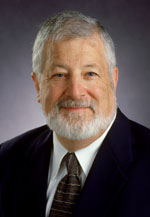Bio: H. Neal Bertram came to UCSD in 1985 as the Endowed Chair Professor in Electrical and Computer Engineering. He leads CMRR's recording physics and micromagnetics research. He earned his Ph.D. in physics from Harvard in 1968, then worked for AMPEX Corporation. He is the author of the highly-regarded 'Theory of Magnetic Recording' (Cambridge University Press, 1994). He was co-recipient in 2000 of the National Storage Industry Consortium's Technical Achievement Award for modeling and system simulations paving the way to a 100Gb/sq.in. hard disk drive system. An IEEE Fellow, he received the 2003 IEEE Reynold B. Johnson Information Storage Award.
Research: Professor Bertram is a leading research scientist exploring the fundamental physics of magnetic recording processes and materials. His goal is to understand all the issues involved with the continued growth in magnetic storage density and data rate. He is an expert on the behavior of magnetic grains in thin-film storage media at the heart of storage devices such as disk and tape-drives. In such media, each data bit cell is composed of a small volume of about 200 magnetic grains, typically of Cobalt or Iron alloys. Higher densities require smaller grains, but smaller grains are more prone to switch polarity due to random (stochastic) thermal fluctuations. The 10-year data reliability standard sets a minimum grain size and hence a maximum system signal-to-noise ratio. Bertram also studies magnetic dynamic relaxation, which controls data rate (how rapidly magnetic grains can be reversed) and optimal medium design. A key issue is the grain anisotropy direction, which sets the magnetization orientation. Perpendicular recording (out-of-plane grain orientation) may provide better signal and thermal stability at higher densities than conventional longitudinal recording (in-plane orientation). A new hybrid medium design developed in Bertram's lab allows for ultra high areal densities (1-2 Terabits/in.sq.) about an order of magnitude greater than predicted even for perpendicular recording. Also newly created: large-scale numerical computer codes that simulate the entire dynamic recording process, including the transducers that write and read recorded data. This work involves supercomputers (SDSC-NPACI) and has recently led to novel transducer designs.
|

